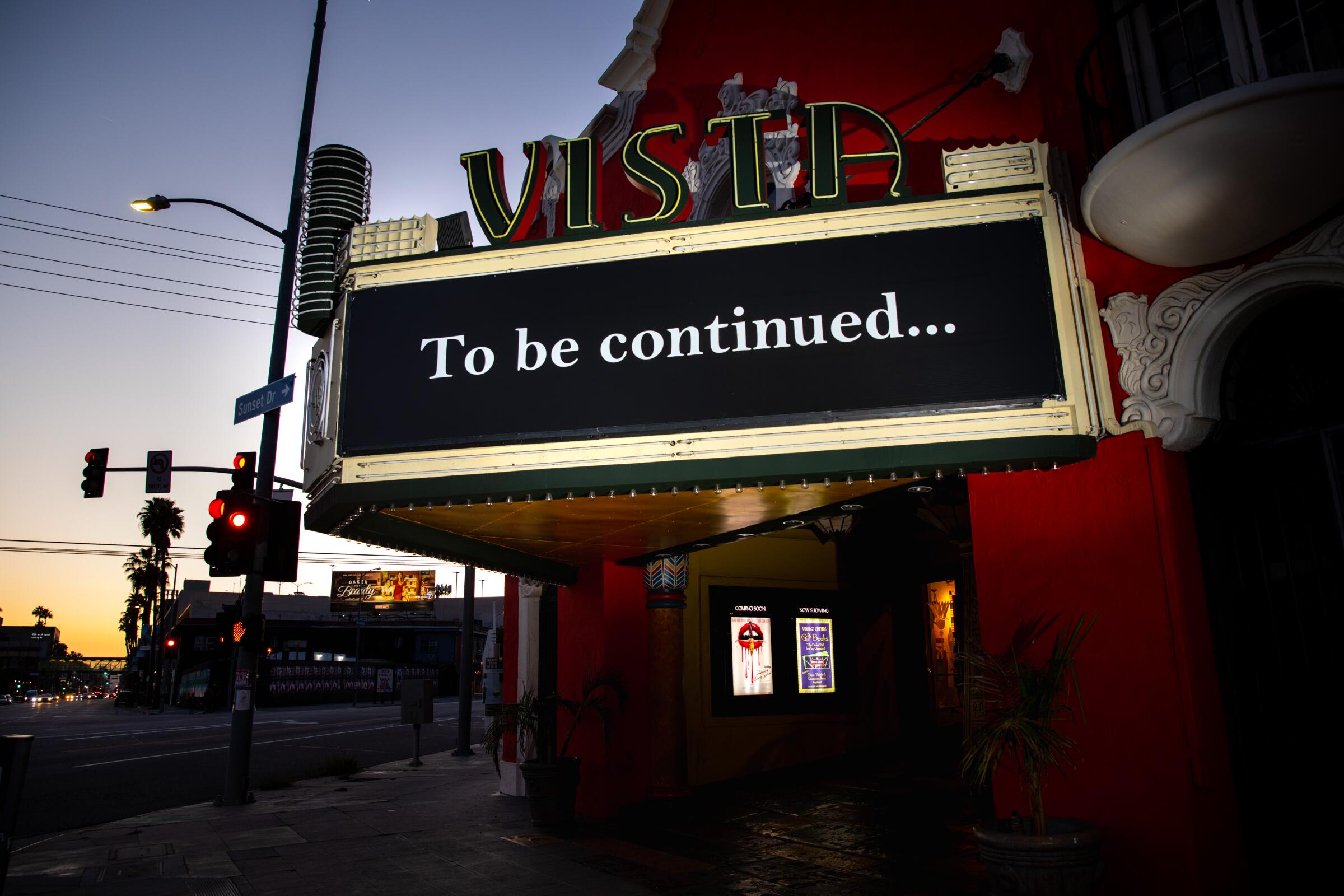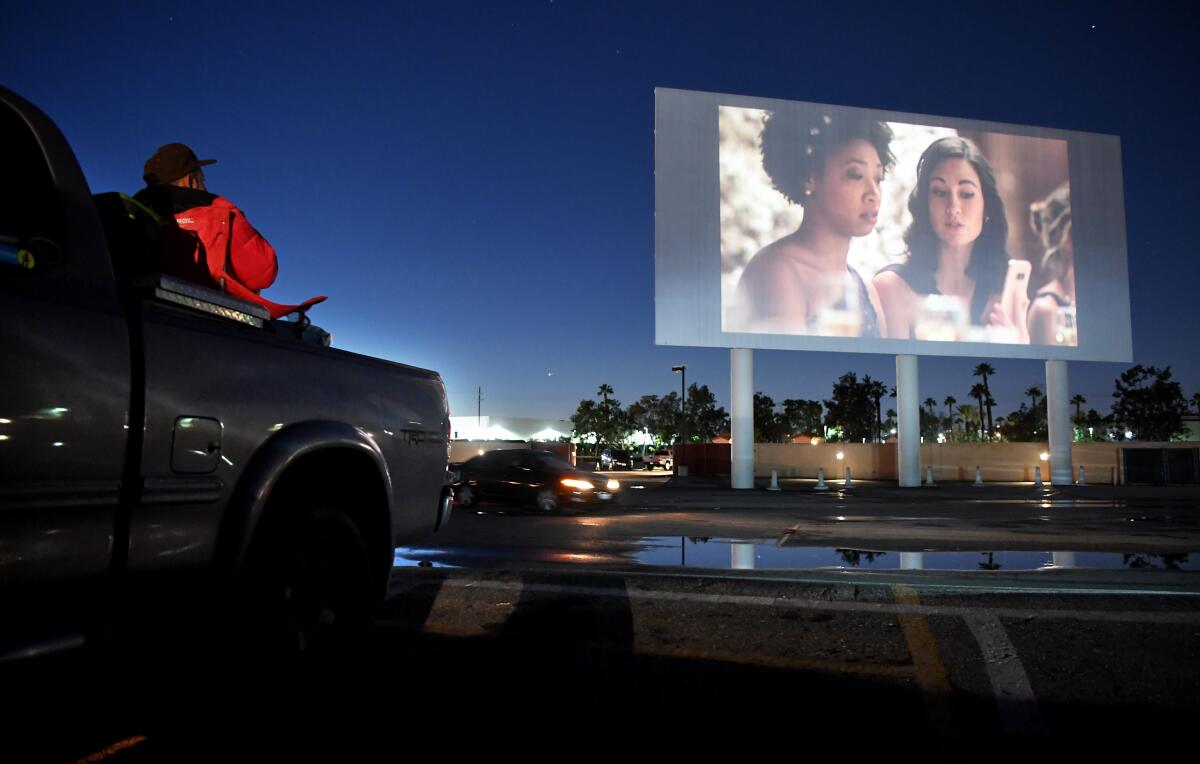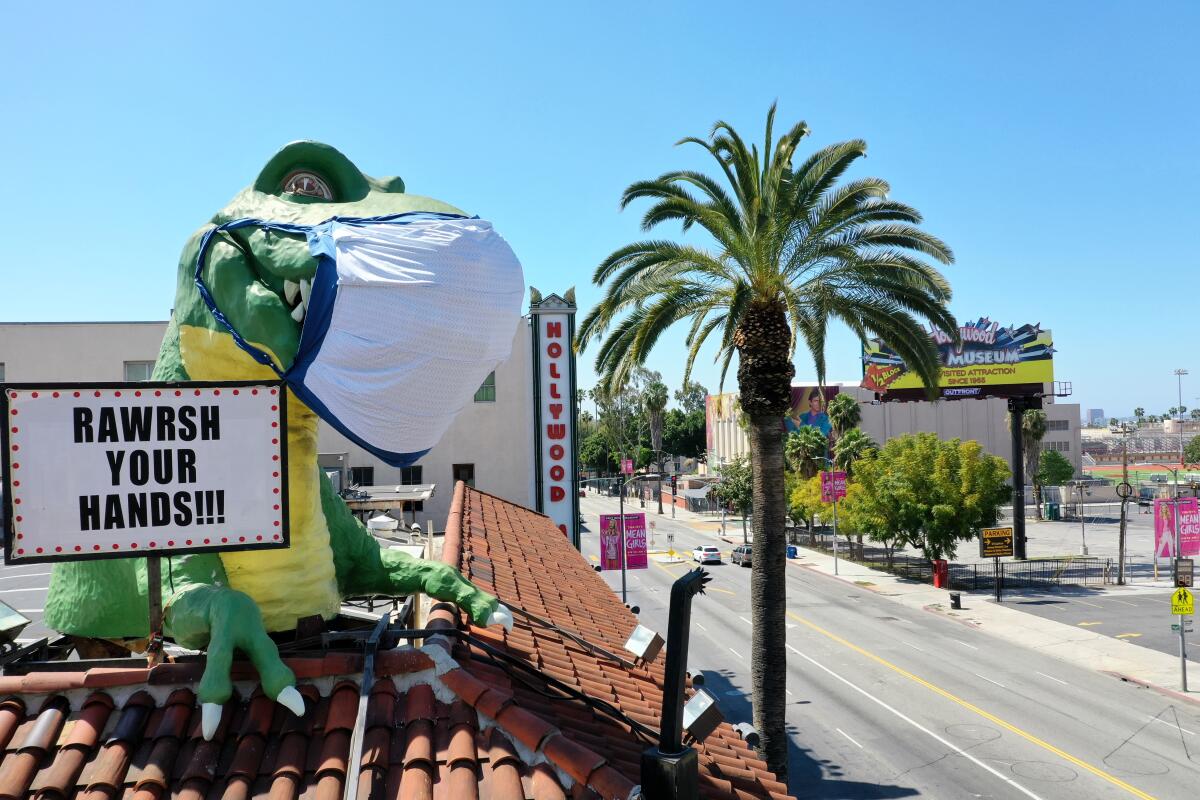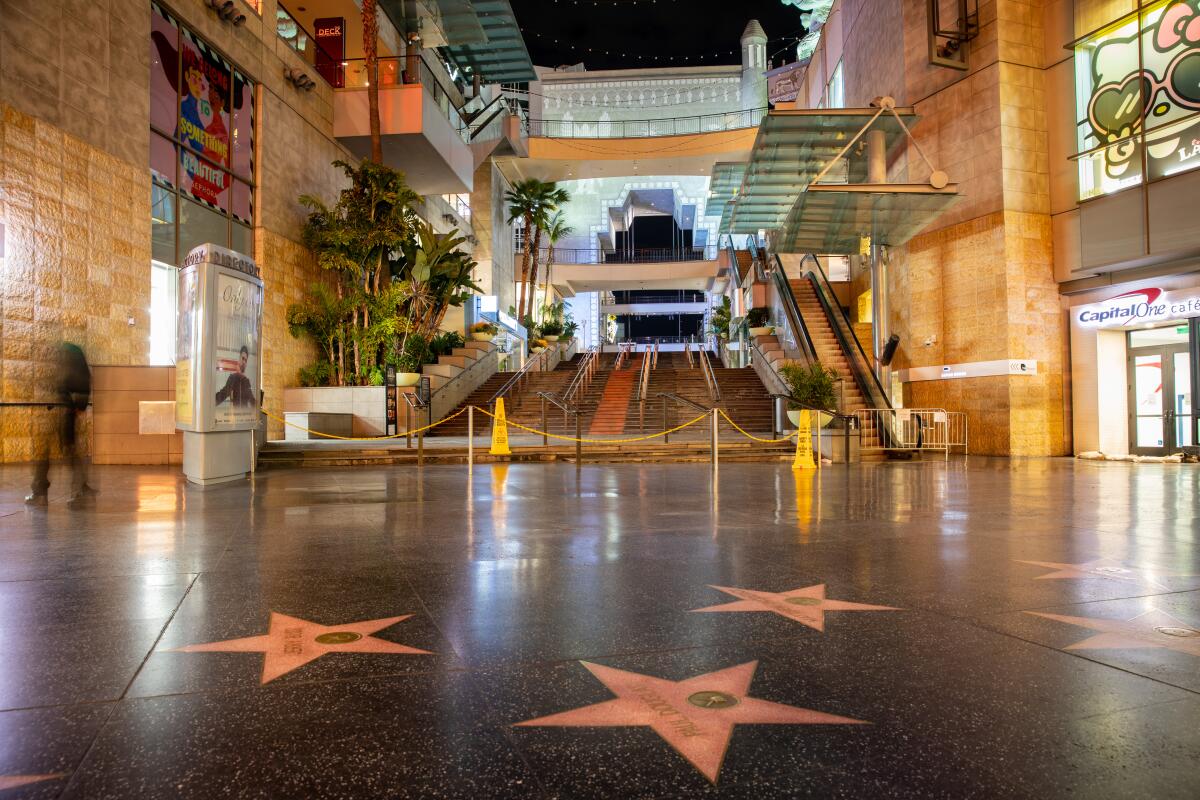Only good movies
Get the Indie Focus newsletter, Mark Olsen's weekly guide to the world of cinema.
You may occasionally receive promotional content from the Los Angeles Times.

Images coming out of the devastating COVID-19 pandemic seem like the stuff of a Hollywood post-apocalyptic horror movie that has become, frighteningly, all too real.
After all, just a decade ago Steven Soderbergh was preparing to shoot “Contagion,” about a fictional pandemic that wreaks havoc across the globe. Now he’s leading a Directors Guild task force devising workplace guidelines to address a real one.
When Hollywood hit pause along with many of the nation’s industries, the shutdown rippled across the film ecosphere, touching everyone from those in studio boardrooms to the crews that keep movie sets running to the audience now staying home. As the industry tries to figure out how to move forward, professionals from across the production pipeline are wondering not just when they might get back to work, but also what a post-pandemic movie set will even look like.
The Times invited a spectrum of film professionals to share their feelings, moods and predictions about the future and the prospect of returning to work — safely — in a post-pandemic world, whenever that may be. Here’s what they said.
GINA PRINCE-BYTHEWOOD (Director, writer, “Beyond the Lights”): When the shutdown first happened, every studio, every company, was saying we’re shutting down for two weeks. But everybody knew that was wishful thinking. You could just sense this was going to get bigger. Now I get the sense productions will start back up in June.
KAY CANNON (Director, “Blockers”): At first, I briefly thought the hiatus would only be for a few weeks. Then I thought a few months. Now the timetable is less clear because it depends on when measures can be put in place to ensure the safety of the cast and crew. Comprehensive testing and tracing is the first step in that process. I’ve come to accept that no one knows anything and that patience is our best friend.
JODY LEE LIPES (Cinematographer, “A Beautiful Day in the Neighborhood”): I want to believe that production will be back before the end of the summer, but part of me thinks the risk isn’t worth it. I want to be able to support my family and do what I love, but only if everyone involved feels safe.
With California debating reopening during the coronavirus, what’s next for the movies? We asked Hollywood
AKIVA GOLDSMAN (Producer, writer, “A Beautiful Mind”): [The production shutdown] happened relatively quickly in California, so therefore I imagined it would be over relatively quickly. Now I wrote “I Am Legend,” so you would think that I would know better. But I sort of thought, ‘Well, they said a month, it’ll be a month.’ And then we’ll be back up and running somehow. That was clearly wrong. I think now I’m hoping for the fall.
ROY LEE (Producer, “It: Chapter Two”): Initially, when the shutdowns began, I feared that we would have to wait for a vaccine to be developed before any production would be back up and running. But now I’m optimistic that there will be a plan in place to allow for smaller-scale productions to start before a vaccine is developed. I have a project called “Shut-In” at New Line Cinema, which is a one-location movie with a very small cast. I believe that it will be one of the first studio productions that will start once we figure out the proper protocols that will ensure that the cast and crew are as safe, if not more, during production than they would have been pre-pandemic.
JASON BLUM (Producer, “The Invisible Man”): I do think smaller productions will start sooner, but I don’t think we’re going to see Marvel movies shooting, or big expensive movies, until 2021. The real answer to your question is that it’s all about when testing will be in this country as good it is in other places, which it isn’t yet.
SOPHIA TAKAL (Director, co-writer, “Black Christmas”): I came up making micro-budget movies with very small crews and limited cast/locations, so I’d feel safe returning to a film set with a skeleton crew where everyone had been quarantined for the two weeks prior to production even now. I’d feel safe on a larger set if everyone could get rapid tested every day and wore masks and there was hand sanitizer everywhere and nobody ever sneezed, coughed or breathed very heavily in public, which is obviously not realistic.
LIPES: A socially distant film set isn’t a film set ... it’s something else. I’ve heard of a few productions shooting that are restricted to just people in their home with the gear they have and no one outside their family involved. But, that’s a limiting arrangement. I don’t think people can be on set together in the world and be 100% sure they are not spreading the virus.
NICKI LEDERMANN (Makeup, “Joker”): As a makeup artist I have to touch actors. Luckily we already are trained to be sanitary and exercise extreme caution not to spread germs or viruses to and from actors, regardless if they are airborne or blood borne. Stricter and enhanced safety measures are definitely in order, but to be honest nothing except isolation would be 100% safe.
Like with anything in life we need to adapt to make the work and live environment as safe as possible, for everyone. The only way to do that is for every union to work out what is needed to keep their specific membership safe, then all unions should combine those safety measures and create a plan that works for everyone. I think that way crews would feel protected (enough) and studios would get the insurability they need to start up again.
ALAN HEIM (President, Motion Picture Editors Guild): Everybody was sort of dumped into this really suddenly when they closed down the studios. ... None of us know, there’s a lot of surmising out there, tremendous amounts of guesswork and we don’t know what’s going to happen really. But the unions are trying very hard to stay on top of this and make it safe for our members. All of our members, not only editors; I’m also in touch with presidents of the other unions. We all are very worried about going back to work too soon and unprotected.
With Hollywood on hold, so are the livelihoods of thousands of workers who depend on the film and TV business that has halted during the coronavirus pandemic.
JORDAN HOROWITZ (Producer, “La La Land”): As of right now I personally feel safe returning to small offices, soundstages, D.I. facilities, etc. that are consistently cleaned and follow social distancing guidelines and have reasonable limits on who is coming and going on a day-to-day basis. Film sets … I’m not sure how I feel just yet, and I’m grateful that I don’t have anything in this moment that needs to be shooting. Every film set I’ve ever been on has been a breeding ground for collective sickness, in one form or another.
LORI BALTON (Location manager/scout, “Once Upon a Time … in Hollywood”): It seems to me that on-location work would be preferable to be shooting inside a soundstage with recirculating air breathed in and out by 100-200 crew members. I would also imagine a niche for environmental cleaning companies with regard to testing and remediation in both prepping and restoring locations. I hope it doesn’t just slide back into “business as usual,” because that second wave is going to hit if we lower our guard.
SIMU LIU (Actor, “Shang-Chi and the Legend of the Ten Rings”): As badly as I want to get back to work and start making things again, I think our collective priority should be supporting our essential workers until either a vaccine is created or this disease is brought under control. Neither of those things have happened, so I’m focused on staying home, keeping busy and giving what I can to ensure that people working on the front lines have the protective equipment they need.
JANICZA BRAVO (Director, co-writer, “Zola”): If there isn’t access to daily testing I’m into watching from inside what that first round of returning looks like. I think there’s gotta be a line in the budget for medical staff. It means hiring nurses on site, on sets, at studios. If not that, I’d want to build a kind of ecosystem. There’s a Pauly Shore movie from the ’90s called “Bio-Dome.” You create a home to house a small cast and crew. You create a home to house your set or sets. One travels to and from there only. Via tunnels preferably. And everyone is tested before. Everything that comes in and out is monitored. Perhaps a more solid film to reference would be Todd Haynes’ “Safe.” I want that. An environment with very few.
WILL PACKER (Producer, “Girls Trip”): I’m sure I’m like a lot of executives who have been extremely busy during this time. Communication has not only continued but increased. As someone who routinely flies back and forth across the country it’s been a real eye opener to see the level of productivity that can be sustained when leaning on the technology available. I expect that to continue and be refined as we move forward.
CANNON: Like everyone, I’ve realized that 90% of meetings can be done over Zoom. The other 10% didn’t need to happen at all.
HOROWITZ: Most meetings can be Zooms. Most calls can be emails. Most friendships can be texts (jkjk).
TAKAL: I really do not like doing things remotely. All the technology I’m using now is helpful for staying connected/productive during the quarantine, but I’m not interested in thinking about how this technology will make things more efficient in the future. I think efficiency destroys art and human connection feeds it.
From a look at Barack Obama’s White House photographer to a personal production on the streets of Germany, many documentaries are still in production during quarantine thanks to technology, smaller crews and archival footage.
ADIR ABERGEL (Hair stylist for clients including Charlize Theron and Marion Cotillard): What I realized through the shutdown is that the technology that was driving me nuts on a daily basis has become my best friend. Social was a great way to come together and start conversations over IG Live, Zoom and FaceTime.
My business depends on personal interaction, but using technology to walk clients through hair color application has been incredible. I’ve done multiple [videos] recently, whether on FaceTime or Zoom, to teach clients ways to cut and style their hair and help them realize that taking care of themselves on a daily basis is an important part of mental health.
BLUM: I hate video conferencing, but it has gotten me used to video conferencing. I do think there are a lot of meetings that will be a lot better for the planet if people aren’t jumping on planes. I don’t think video conferencing is a substitute for being in a room with someone, but it is better than just talking on the phone. There are so many ways you communicate with your expression, in such a profound way … when it’s delayed and small, you just lose that. My feeling is it’s 50% as good as an in-person meeting. But I do think there are a lot of meetings we have in-person, out of habit, that don’t need to be.
KENNETH BRANAGH (Director, producer, actor, “Death on the Nile”): My own instinct — and it’s nothing more than that — is that I, for one, am certainly missing the communal experience and just being with people. I absolutely love going to the movies. I love sharing stories and watching them together on the big screen, being part of audiences that laugh or get scared or get thrilled together. And I’d hate to think that we’re going to miss that.
We’re going to have to adapt. I’m fundamentally an optimist, but these are challenging times and they challenge anyone’s optimism. There’s no question these are dark days. We’re living in this period of momentous change, but I believe that things that are important to us will return ... I do think that a desire for the communal experience is who we are, and I hope that we have the privilege of being able to return to it sometime soon.
BRAVO: I am really into the idea of bringing back the drive-in. Or finding unconventional outdoor spaces for screening. If we think like that especially in the independent space it might mean that a small film could kill it in North Dakota or Iowa or Kansas. We could really rally around and eventize this kind of viewing experience so as to not totally suck the lifeblood out of going to the movies.
BRYAN SMILEY (President of film and television, HartBeat Productions): I think we have to ask ourselves, “Can we produce films in a manner that the economics work for both streaming and theatrical distribution?” I imagine studios are going to want the flexibility to pivot distribution plans depending on what’s happening in the marketplace at any given moment.
BLUM: To me, watching a movie on TV or a show on TV or streaming is the equivalent to a Zoom call, whereas seeing a movie in a theater is the equivalent of a live meeting. As much as theaters are clearly suffering now, I think the choice that people have in theaters may change, the amount of time that movies stay in theaters may change, but I don’t think theatergoing is going away. It’s going to change ... but I don’t think it’s going away.
The releases of “Trolls World Tour,” “The Lovebirds” and “Artemis Fowl” illustrate the different ways studios are navigating the COVID-19 pandemic.
GOLDSMAN: I think movies were and have been heading towards the rock concert, the event. And I think that this will accelerate that. So I think people will return to movies, but I think they will return to movies more for the most special, that if you can get it on streaming, you will now. And you’ll want the bigger light and sound show for the communal experience. And so I think they’ll come back probably at the same rate concerts come back.
PRINCE-BYTHEWOOD: This is the big question that scares me. I love going to the movies, and I make movies for an audience. I want theaters to thrive again. I think seating will have to change. Sitting every other seat, or pulling seats out to have fewer in the theater. And maybe theaters can have the technology that can read the temperatures of patrons as they enter. But it is also obvious that streaming will absolutely dominate. Staying at home will always be the safest option.

LIPES: The uninsured, people who get paid the least, people who have the smallest amount of savings, people who don’t have access to good medical care, and people who have or care for people with pre-existing conditions. I think the same group of people who are hardest hit outside of the film community.
BALTON: The smaller vendors who couldn’t hold on through this two-month closure. We’re starting to see it with our business partners in the LMGI [Location Managers Guild International], the smaller mom-and-pop-style location vendors who have supported on-location filming for years. I hope they can all weather the storm and be there on the other side of the curve, but I fear that many cannot pay their employees and may not be able to survive the economic devastation.
During the coronavirus crisis Hollywood group sets up fund to provide relief for low-paid assistants
ARIANNE PHILLIPS (Costume designer, “Once Upon a Time … in Hollywood”): Below-the-line crews, all workers, businesses that support the film industry, crafts people from tailors to shoemakers, dry cleaners, restaurants, camera houses, prop houses, florists, etc.
SMILEY: If you listen to the experts, you hear that a vaccine is potentially many months away. If this is in fact true, which I believe it is, I think any person who is at high risk for developing complications from the virus will not be able to work. I believe this will be especially true for older professionals. I worry they may not be able to find work due to any perceived risk associated with their age.
CANNON: At long last, this issue was gaining a lot of visibility in the industry. It’s important that it not get pushed aside, particularly when we know marginalized communities are being disproportionately affected by the pandemic. It’s vital that those voices continue to be elevated.
TAKAL: One of the first things I wondered was whether or not this would erase the progress Hollywood has made in inclusivity. With everyone looking for a job at the same time, will the “powers that be” go back to hiring mainly cis white men? I have no idea; I really hope it’s not true. That things will slide backwards is a fear of mine — one that precedes the pandemic.
PACKER: I would hope it wouldn’t have a cooling effect on those initiatives. However we need to get back to (and hopefully exceed) pre-COVID production levels. Marginalized communities in the industry are the hardest hit when there are depressed levels of production.
SMILEY: I think in times of uncertainty executives often turn to “safe bets” or the “tried and true.” I fear that what is considered a “safe bet” will only include established filmmakers, which historically have not been a diverse group of people.
BLUM: I am concerned that people will be less likely to take risks on artists who have slightly less experience. But I hope that we haven’t lost the progress the industry has made over the last couple years on that front. I don’t think we’ll lose it, but I don’t know if it’s going to go as quickly as it had been going before this happened.
PRINCE-BYTHEWOOD: I won’t blame the pandemic on the lack of inclusion and diversity. But Hollywood will find a way to.

BRAVO: What if this happens again? How do we care for our most vulnerable? How do we reimagine if these are our limitations? I don’t want to watch a year of Zoom movies — that sounds sad. I keep hearing that this is a great time to create and write. I remember “great time” — this ain’t it.
SMILEY: The overall economy and rising unemployment. If people are struggling to pay rent and put food on their tables, I don’t think they’ll have disposable income for tickets or subscriptions.
LIU: While the world fights the COVID-19 virus, the Asian population is also experiencing an unprecedented level of xenophobia and prejudice in America and all over the world. The website Stop AAPI Hate, which was created last month by the Asian Pacific Policy and Planning Council to track anti-Asian hate crimes around the country, reported over 1,100 racially-motivated attacks [in America] in the last two weeks of March alone. ... It’s lazy and dangerous to point a finger at a group of people you know nothing about and reduce them to harmful stereotypes. I would encourage everyone reading not to give in to hate and to instead focus their thoughts around empathy and support.
LIPES: I worry about the psychological effect this will have on children, how it shapes their view of the world, the socialization they are missing out on, and the dominance of screens when we are all trapped in our homes.
Movie theaters might start opening up as soon as mid-June. That’s going to be more complicated than it sounds.
BLUM: What I think COVID is going to do is wildly accelerate the consolidation of power amongst six companies. We were going in that direction, but the power of Netflix, Amazon, Apple already in streaming, Comcast, Disney, AT&T starting their streamers — I think we were going in a world where those guys were going to control a big bite of distribution and now I think that’s going to happen even more quickly.
PACKER: My biggest concern is a rush to “normalcy” in society that contributes to subsequent waves being more deadly than they have to be.
LEE: One issue that might be a problem is, how will Hollywood creatively address the “new normal” where social interactions like hugging, handshakes and other contact between people will be depicted on screen? When I’m watching a movie or TV show and I see things like that, I’m thinking, “That won’t be depicted the same way post-pandemic.” But will a vaccine change things back? If so, will movies and TV shows look dated if changes were made for that period of time when there was no vaccine?
CANNON: This question is giving me a panic attack. What else should I be worried about?

BRAVO: I miss lying about being busy while doing nothing at all. I miss ignoring calls because I’m busy doing nothing at all.
PRINCE-BYTHEWOOD: I’m in the middle of post on a film I have worked two years on [“The Old Guard,” starring Charlize Theron, for Netflix]. And I feel like we are limping toward the finish line. We are doing everything remotely — ADR, score, mixing, color-timing. It’s getting done, but it is not ideal. It’s such a collaborative process, and you lose some of that when everyone is separated.
BLUM: The lack of the theatrical experience. I have never been alive at a time when I didn’t look at the grosses of the movies that were coming out over the weekend 15 times — not for who made what money, but for what that represented. In other words, what kind of movies the audience was really responding to, why they were responding to one over another, the endless surprise that happened every weekend as a result of that. No one ever really knew until the movies came out. Sometimes I was happy, sometimes I was sad, sometimes I was disappointed, sometimes I was elated — but I loved the thrill of that! And it’s just gone. That’s probably what I miss most.
Times entertainment columnist Glenn Whipp and film critic Justin Chang sat down to reminisce about their favorite movies and moviegoing experiences of the season.
TAKAL: I mainly miss going to the movies.
PHILLIPS: I miss all of it, prepping a film, collaborating with creatives, hiring and collaborating with my own crew, shooting and being on a film set. I do not miss traveling and being away from home and family.
LEDERMANN: Human connection, to be inspired by working hands-on with other creative people. And my paycheck.
Times staff writer Josh Rottenberg contributed to this report.
Only good movies
Get the Indie Focus newsletter, Mark Olsen's weekly guide to the world of cinema.
You may occasionally receive promotional content from the Los Angeles Times.